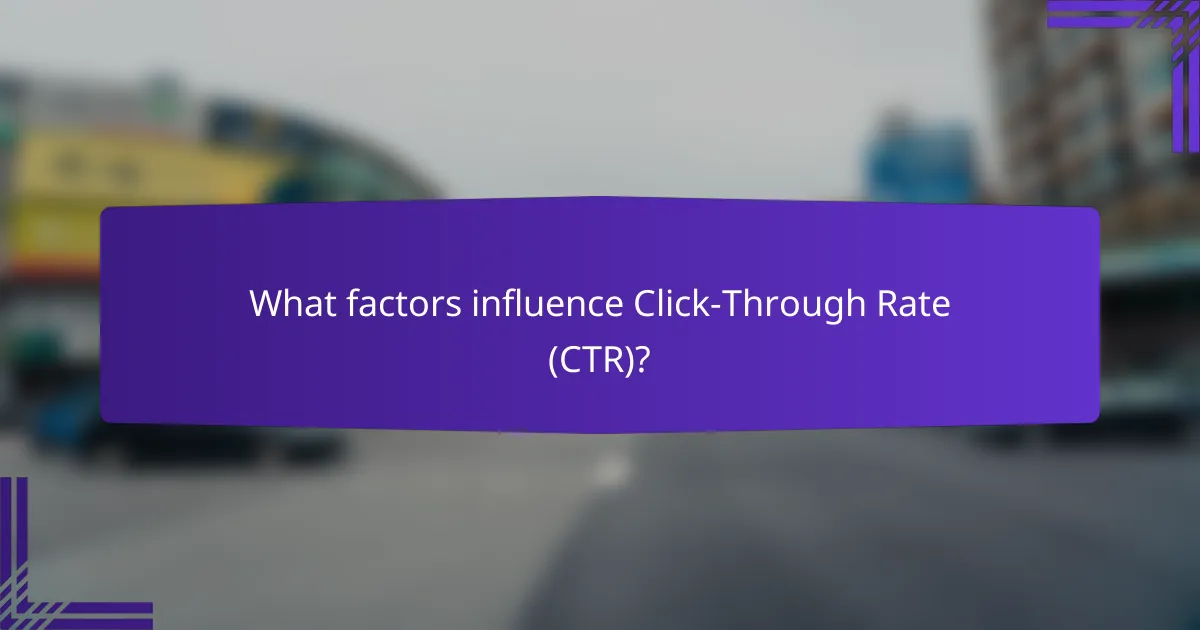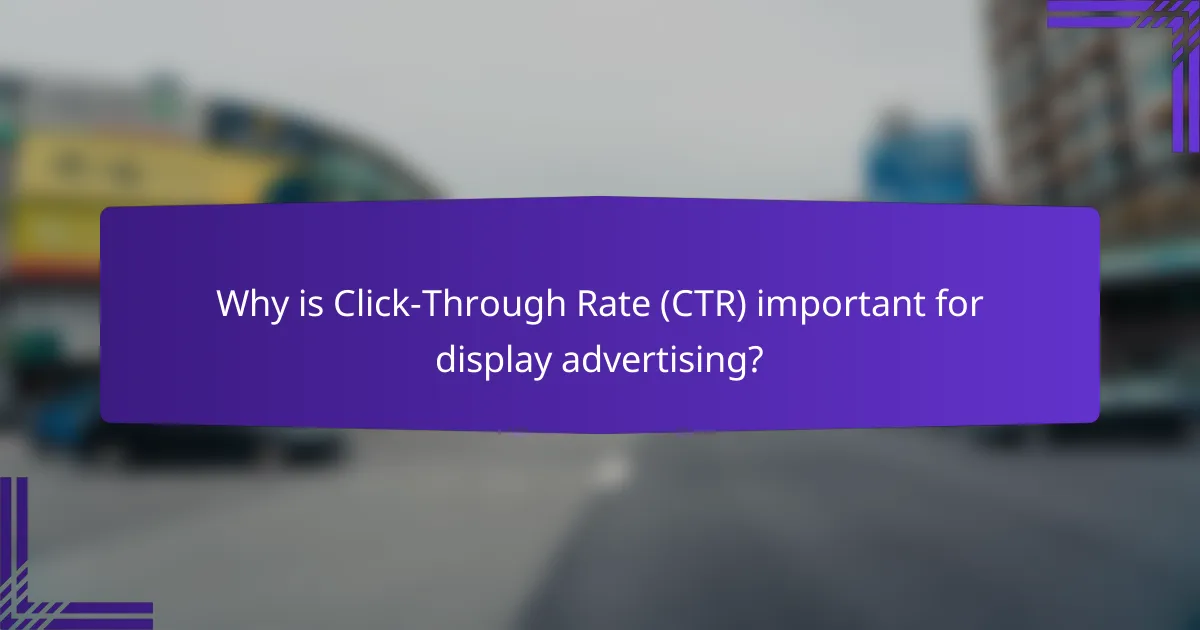Click-Through Rate (CTR) is a vital metric in display advertising that gauges how effectively ads engage users. A higher CTR signifies that an ad resonates well with its target audience, providing insights for optimization and enhancing overall advertising performance. By focusing on factors such as ad copy, placement, and audience targeting, advertisers can significantly improve their CTR and drive better engagement.

How can you improve Click-Through Rate (CTR) in display advertising?
Improving Click-Through Rate (CTR) in display advertising involves several strategic actions that enhance ad engagement. Focus on optimizing ad copy, targeting the right audience, and refining visual elements to effectively boost CTR.
Optimizing ad copy
Ad copy should be clear, concise, and compelling to capture attention quickly. Use strong action verbs and highlight the unique benefits of your product or service. For instance, instead of saying “Our software is great,” say “Boost your productivity by 50% with our software.”
Keep the message relevant to the target audience and ensure it aligns with their needs and preferences. Experiment with different headlines and body text to find what resonates best.
Using targeted audience segmentation
Targeted audience segmentation allows you to tailor your ads to specific groups based on demographics, interests, or behaviors. This increases the likelihood that your ads will be relevant and engaging to viewers.
Utilize data analytics tools to identify segments that respond well to your advertising. For example, if your product appeals to young professionals, focus your ads on platforms where this demographic is most active.
Implementing A/B testing
A/B testing involves creating two versions of an ad to see which performs better. This method helps identify effective elements such as headlines, images, or calls-to-action.
Run tests over a reasonable timeframe to gather sufficient data. Analyze the results to make informed adjustments that can lead to improved CTR. Aim for a minimum of a few hundred impressions per version to ensure statistical significance.
Enhancing visual elements
Visual elements play a crucial role in attracting attention and conveying your message. Use high-quality images or graphics that are relevant to your product and resonate with your audience.
Consider the color scheme and layout; contrasting colors can make your ad stand out. Additionally, ensure that the design is mobile-friendly, as a significant portion of users access ads on mobile devices.
Utilizing compelling calls-to-action
A strong call-to-action (CTA) is essential for encouraging users to click on your ad. Use phrases like “Get started today” or “Claim your free trial” to create urgency and prompt action.
Position the CTA prominently within the ad design and ensure it is visually distinct. Test different CTAs to see which generates the highest engagement, and refine your approach based on user response.

What factors influence Click-Through Rate (CTR)?
Several factors significantly influence Click-Through Rate (CTR), including ad placement, relevance, targeting accuracy, and format. Understanding these elements can help optimize your advertising strategy and improve engagement rates.
Ad placement
Ad placement refers to the location of your advertisement on a webpage or within an app. Ads placed above the fold, or in prominent positions, generally receive higher visibility and engagement. Experimenting with different placements can help identify the most effective spots for your audience.
Consider the context of the content surrounding the ad as well. Ads that align well with the adjacent content tend to perform better, as they feel more integrated and relevant to the user experience.
Ad relevance
Ad relevance is crucial for attracting clicks. Ads that closely match the interests and needs of the target audience are more likely to be clicked. Conducting thorough keyword research and audience analysis can enhance ad relevance.
Utilizing dynamic ad features that personalize content based on user behavior can further increase relevance. For instance, showing products related to previous searches can significantly boost CTR.
Targeting accuracy
Targeting accuracy involves reaching the right audience with your ads. Effective targeting can be achieved through demographic, geographic, and behavioral data. The more precise your targeting, the higher the likelihood of engagement and clicks.
Utilizing tools like audience segmentation and retargeting can help refine your targeting strategy. Avoid broad targeting, as it can dilute your message and reduce CTR.
Ad format
The format of your ad plays a significant role in CTR. Different formats, such as text, image, video, or interactive ads, can yield varying results depending on the platform and audience. Video ads, for example, often capture more attention than static images.
Testing various formats can help determine which resonates best with your audience. Ensure that the chosen format aligns with the platform’s best practices to maximize engagement and clicks.

Why is Click-Through Rate (CTR) important for display advertising?
Click-Through Rate (CTR) is crucial for display advertising as it measures the effectiveness of ads in attracting user engagement. A higher CTR indicates that an ad is resonating with its audience, leading to better performance and optimization opportunities.
Measures ad effectiveness
CTR serves as a key indicator of ad effectiveness by showing how many users clicked on an ad compared to how many saw it. A low CTR may suggest that the ad is not appealing or relevant to the target audience, prompting a review of the ad’s design, messaging, or placement.
For example, if an ad receives 1,000 impressions but only 10 clicks, the CTR is 1%. This low percentage signals a need for adjustments to improve engagement.
Impacts Quality Score
In platforms like Google Ads, CTR significantly influences the Quality Score, which affects ad placement and cost-per-click. A higher Quality Score can lead to lower costs and better ad positions, making CTR a vital metric for advertisers aiming to maximize their budget.
To improve Quality Score, focus on creating relevant ads that align with user intent. Regularly testing different ad variations can help identify which messages drive higher CTR and, consequently, a better Quality Score.
Affects overall campaign ROI
CTR directly impacts the return on investment (ROI) of advertising campaigns. A higher CTR typically leads to more conversions, which can enhance overall profitability. Conversely, a low CTR can result in wasted ad spend and lower returns.
To optimize ROI, monitor CTR alongside conversion rates. If a campaign has a high CTR but low conversions, it may indicate that while users are clicking the ad, the landing page or offer may not be compelling enough to convert them into customers.

What is the definition of Click-Through Rate (CTR)?
Click-Through Rate (CTR) is a metric that measures the effectiveness of an online advertising campaign by calculating the ratio of users who click on an ad to the total number of users who view the ad. A higher CTR indicates that the ad is engaging and relevant to the audience.
Percentage of clicks on an ad
The percentage of clicks on an ad is a direct reflection of its performance in attracting user interest. For example, if an ad receives 1000 impressions and 50 clicks, the CTR would be 5%. This percentage helps advertisers gauge how well their ads resonate with potential customers.
Understanding the percentage of clicks can guide marketers in optimizing their ad content, targeting, and placement. A typical CTR can vary widely depending on the industry, with averages ranging from low single digits to high teens.
Calculated as clicks divided by impressions
CTR is calculated by dividing the number of clicks an ad receives by the number of impressions it generates, then multiplying by 100 to get a percentage. The formula is: CTR = (Clicks / Impressions) x 100. This straightforward calculation provides a clear view of ad performance.
When analyzing CTR, it’s crucial to consider the context of the campaign. Factors such as ad placement, audience targeting, and creative quality can significantly impact the number of impressions and clicks. Regularly monitoring and adjusting these elements can lead to improved CTR over time.

How does Click-Through Rate (CTR) impact advertising costs?
Click-Through Rate (CTR) significantly influences advertising costs by determining how effectively ads attract clicks. A higher CTR often leads to lower costs per click, as it indicates better ad performance and relevance to the audience.
Influences cost-per-click (CPC)
CTR directly affects cost-per-click (CPC) in online advertising. Advertisers with higher CTRs typically enjoy lower CPCs because platforms like Google Ads reward engaging ads with better positioning and reduced costs. For instance, a campaign with a CTR of 5% might incur a CPC of $0.50, while a lower CTR of 1% could see costs rise to $2.00.
Maintaining a high CTR can lead to significant savings over time, especially for campaigns with large budgets. Regularly analyzing ad performance and making adjustments can help sustain or improve CTR, ultimately lowering overall advertising expenses.
Affects bidding strategies
CTR plays a crucial role in shaping bidding strategies for digital advertising. Advertisers often adjust their bids based on expected CTR, as higher-performing ads can justify higher bids due to their potential for better returns. For example, if an ad has a proven track record of a high CTR, an advertiser may choose to bid more aggressively to secure prime ad placements.
Additionally, understanding the relationship between CTR and bidding can help advertisers optimize their campaigns. A common strategy is to test different ad variations to identify which ones yield the highest CTR, allowing for more informed bidding decisions. This approach can maximize ad visibility while managing costs effectively.
